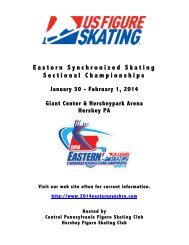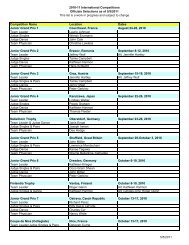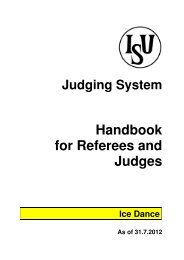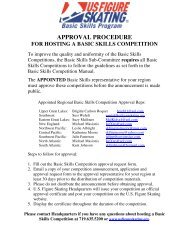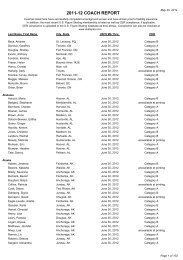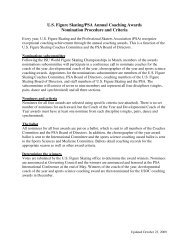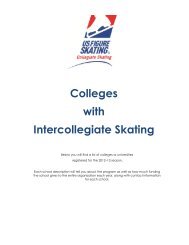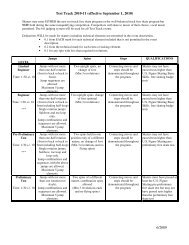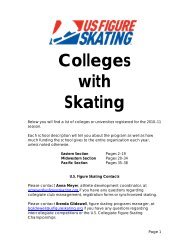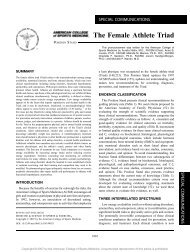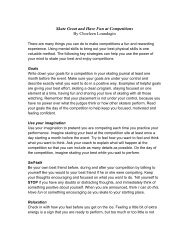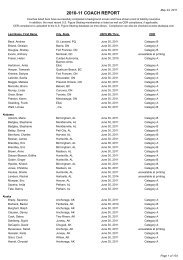RECREATIONAL THERAPEUTIC - US Figure Skating
RECREATIONAL THERAPEUTIC - US Figure Skating
RECREATIONAL THERAPEUTIC - US Figure Skating
You also want an ePaper? Increase the reach of your titles
YUMPU automatically turns print PDFs into web optimized ePapers that Google loves.
SPECIAL OLYMPICS&<strong>THERAPEUTIC</strong> SKATINGPROGRAMS MANUALA Publication of U.S. <strong>Figure</strong> <strong>Skating</strong>
SPECIAL OLYMPICS & <strong>THERAPEUTIC</strong> SKATINGPROGRAMS MANUALDeveloped byU.S. <strong>Figure</strong> <strong>Skating</strong>Program Development CommitteeTechnical Editors:Sandy LambDr. Kurt OppeltCathleen Pavlis OppeltRevision of the 1976 Program Aids Series 8Copyright © 1990 (rev 1999, 2005) U.S. <strong>Figure</strong> <strong>Skating</strong>
TABLE OF CONTENTSACKNOWLEDGEMENTSABOUT U.S. FIGURE SKATING<strong>THERAPEUTIC</strong> SKATINGSPECIAL OLYMPICSEXAMPLES OF SUCCESSFUL <strong>THERAPEUTIC</strong> & SPECIAL OLYMPIC PROGRAMSREPORT FORMAT AND FORMTEACHING TIPSTEACHING TIPS REPORT FORMEQUIPMENTREFERENCES
ACKNOWLEDGEMENTSThe U.S. <strong>Figure</strong> <strong>Skating</strong> Special Olympics and Therapeutic <strong>Skating</strong> Committeeexpresses its appreciation to the clubs and individuals who contributed information forthe revision of this manual and directory.We would like to continue to make additions as information becomes available to us. Itis hoped that the manual will continue to grow and serve as a sharing network ofinformation. Those in the field of recreational therapeutic and/or Special Olympicprograms are encouraged to share information about their local programs or techniquesthat they have found to be of value. Forms are included for your response following theExamples of Successful Therapeutic & Special Olympic Programs and the TeachingTips sections.Please send information to:U.S. <strong>Figure</strong> <strong>Skating</strong>Special Olympics and Therapeutic <strong>Skating</strong> Committee20 First StreetColorado Springs, CO 80906
ABOUT U.S. FIGURE SKATINGU.S. <strong>Figure</strong> <strong>Skating</strong> is the national governing body for the sport of figureskating in the United States. U.S. <strong>Figure</strong> <strong>Skating</strong> is a member of theInternational <strong>Skating</strong> Union (ISU), the international federation for figureskating, and is a member of the U.S. Olympic Committee (<strong>US</strong>OC).U.S. <strong>Figure</strong> <strong>Skating</strong> is one of the strongest and fastest growing governing bodies within the Olympicmovement with more than 173,000 members. It is comprised of member clubs, collegiate clubs, schoolaffiliatedclubs and individual members. The charter member clubs numbered seven in 1921 when theassociation was formed and first became a member of the ISU.U.S. <strong>Figure</strong> <strong>Skating</strong>'s national headquarters, located in Colorado Springs, Colo., is also home to theWorld <strong>Figure</strong> <strong>Skating</strong> Museum and Hall of Fame, which is toured by more than 15,000 visitors annually.More than 1,000 volunteers serve on U.S. <strong>Figure</strong> <strong>Skating</strong>'s Executive Committee, Board of Directors andnumerous committees. Thousands of additional volunteers dedicate their time to club activities, judging,officiating and competition management.Nearly 600 clubs and 800 U.S. <strong>Figure</strong> <strong>Skating</strong> Basic Skills Programs with representation from border-toborderare registered with U.S. <strong>Figure</strong> <strong>Skating</strong>.FinanceU.S. <strong>Figure</strong> <strong>Skating</strong> operates on an estimated annual budget of $16 million. Fundraising and competitionearnings account for 81 percent of the revenue. Additional revenue is generated from U.S. <strong>Figure</strong> <strong>Skating</strong>and Basic Skills memberships, the U.S. <strong>Figure</strong> <strong>Skating</strong> Memorial Fund, the U.S. <strong>Figure</strong> <strong>Skating</strong>Foundation, publications and U.S. Olympic Committee programs.The United States Olympic Committee financially supports U.S. <strong>Figure</strong> <strong>Skating</strong> athletes as well throughthe Basic Grant, Special Assistance and Tuition Grants, Operation Gold and the Basic Plus Grant.More than $3.39 million of the U.S. <strong>Figure</strong> <strong>Skating</strong> budget is utilized for sending athletes to internationalcompetitions, athlete programs, collegiate skating programs, synchronized skating programs andproviding financial assistance for athletes.U.S. <strong>Figure</strong> <strong>Skating</strong> allocates $4.8 million of its budget to help conduct or assist with major U.S. eventsincluding the State Farm U.S. Championships, three U.S. <strong>Figure</strong> <strong>Skating</strong> invitationals, Smart Ones SkateAmerica, the U.S. Junior <strong>Figure</strong> <strong>Skating</strong> Championships and many more.U.S. <strong>Figure</strong> <strong>Skating</strong> on TV<strong>Figure</strong> skating arguably has the highest visibility of any Olympic sport, consistently receiving highertelevision ratings and more broadcast hours than other major sports in both national and Olympictelevision programming.During the 2002 Olympic Winter Games in Salt Lake City, Utah, total broadcasts averaged a 19.9 ratingwith the ladies free skate broadcast receiving a 29.0 rating/42 share.<strong>Figure</strong> skating broadcasts from the 1994 Olympic Winter Games are the highest-rated Olympic televisionprogramming of all time. The ladies short program from Lillehammer had the sixth-highest rating intelevision history (48.5), placing behind the final episode of “M*A*S*H” and the finale of the “Roots” miniseries.Who watches figure skating?• 70% of women consider themselves figure skating fans• 54% of the total population 12+ is interested in figure skating• 68% are women age 25–54• 65% 1+ years in college
• 63% are in $50M+ income households• <strong>Figure</strong> skating fans are educated and affluent• <strong>Figure</strong> skating is the highest-ranked sport among the U.S. population 12+ in fan base• Women sports fans prefer to watch figure skating over college basketball, college football, tennisand the NHL• <strong>Figure</strong> skating is the most popular spectator sport among American women and their teenagedaughtersU.S. <strong>Figure</strong> <strong>Skating</strong> EventsMore than 1,300 events, which include performances, exhibitions and competitions, are sanctioned byU.S. <strong>Figure</strong> <strong>Skating</strong> each year.The nine regional competitions, followed by three sectional competitions, begin the pipeline of U.S. <strong>Figure</strong><strong>Skating</strong>'s qualifying competitions, which lead top athletes to U.S., World and Olympic levels. For the pastsix years, approximately 3,000 figure skaters per year have competed at the regional level.In addition to the many club, regional and sectional competitions, U.S. <strong>Figure</strong> <strong>Skating</strong> and its memberclubs conduct the U.S. Championships, Skate America and three U.S. <strong>Figure</strong> <strong>Skating</strong> televisedinvitational events each year that feature the top skaters in the world like 2002 Olympic medalistsMichelle Kwan and Timothy Goebel. Skate America is one of the six prestigious events included in theISU Grand Prix of <strong>Figure</strong> <strong>Skating</strong> Series.The U.S. <strong>Figure</strong> <strong>Skating</strong> Championships is the premier event conducted each year by U.S. <strong>Figure</strong><strong>Skating</strong>. The competition features more than 250 skaters competing for national titles in three divisions(senior, junior, novice).The U.S. <strong>Figure</strong> <strong>Skating</strong> Championships is typically held for 10 days in January. Bidding to become ahost city of the U.S. <strong>Figure</strong> <strong>Skating</strong> Championships takes place four years in advance of the event, andbidding for other U.S. <strong>Figure</strong> <strong>Skating</strong> qualifying competitions takes place 2–3 years in advance. Both haverequirements as well as venue specifications to be eligible.U.S. <strong>Figure</strong> <strong>Skating</strong> competitions typically attract an impressive number of national media. The U.S.Championships annually bring in more than 300 national and international journalists, arguably more thanany other Olympic-eligible championship event in the United States.U.S. <strong>Figure</strong> <strong>Skating</strong> Special Olympics and Therapeutic <strong>Skating</strong> CommitteeThe Special Olympics and Therapeutic <strong>Skating</strong> Committee is one of the special committees of U.S.<strong>Figure</strong> <strong>Skating</strong>. Made up entirely of volunteers including coaches, officials, and athletes, the SpecialOlympics Committee is responsible for developing rules and regulations and suitable programs forsubmission to the Special Olympics Sports Rules Committee and working in conjunction with SpecialOlympics International to encourage and promote figure skating within the Special Olympics concept.The Special Olympics figure skating program is a part of the U.S. <strong>Figure</strong> <strong>Skating</strong> Basic Skills programdesigned by U.S. <strong>Figure</strong> <strong>Skating</strong> to be the best beginning ice skating program that serves the needs ofboth the recreational and the competitive skater.
<strong>THERAPEUTIC</strong> SKATINGThe emphasis on physical fitness has focused attention on healthful exercise for everyone, includingpersons who are handicapped, either temporarily or permanently. With this emphasis has come the needfor an understanding of the nature of certain handicaps as well as knowledge of specific exercises thatare helpful to a particular handicapped person. Medical personnel, sports professionals and sportsmindedpeople have shared information and some have concluded that supervised ice skating is abeneficial sport for the rehabilitation of many types of handicaps.ValuesBecause skating requires an erect posture and a certain measure of control, participation in the sport hasbeen found to contribute to better breathing, improved circulation and balance, better posture and overallstrength of body.In overcoming the restrictions of their handicaps through pleasant recreation, the skaters tend to becomemore outgoing. They are provided opportunities to meet new friends with a common interest and toidentify with a group. They encounter fun as they develop confidence and self-respect, not only amongthe skaters in their group, but also among families and friends. Their rehabilitation, as a result of healthfulexercise, may also provide them with an opportunity for greater success in life.In ice skating, an individual sport, skaters can progress at their own rate according to their ability. As asport with little body contact, it enables many who have handicaps to participate safely where they areunable to in shock-absorbing exercise or games such as the trampoline, or in team sports, such asfootball and basketball. Finally, skating is an activity that can be a lifetime recreation.The volunteer who works with programs for the handicapped and who believes that our society needs tocare for those who are less able to care for themselves, receives satisfaction from helping to transform apossibly insecure person with handicaps into a happy, contributing member of society.PurposeDoctors, in increasing number, have been suggesting to patients who are recovering from accidents,heart attacks, and other disabilities that ice skating may help them. Most ice skating activities have beenself-administered in the past because there have been too few leaders to support and supervise arehabilitative program. Today, there are a number of recreational therapeutic and Special Olympicprograms available throughout the country. Different types of programs have been developed to meet theneeds in various communities. Examples of these programs can be found in the Programs section of thismanual.The purposes of the manual and directory are as follows: To provide some understanding and appreciation of the value of ice skating programs for personswith handicaps. To encourage support for the development of ice skating programs for the handicapped, ormainstreaming into Basic Skills programs when possible. To provide an understanding of and suggestions for the effective participation in such programs. To provide information for those seeking to develop programs. To locate programs and individuals involved with such programs. To establish contacts in the field of recreational therapeutic and Special Olympic programs. To establish a sharing network of information.Who Can BenefitPersons with a wide range of handicaps, including those who sustain injuries and who are temporarilyimpaired, may benefit from regular ice skating exercise with the permission of their attending physicians.Among these are the following:1. The mentally retarded2. Those with cerebral palsy
3. Those who have had knee and ankle injuries, especially if adapted devises are used4. Those who have had surgery for hip joint disease to correct the condition5. Those who have sideways curvature of the spine, if corrected by the use of a brace6. Those who have bad posture, balance difficulties, or problems with coordination7. Those who need body conditioning8. Senior citizens9. Those who have had heart surgery10. Those who have psychological problems11. Those who are blind, with orientation and guidance12. Those who are deaf, with visual guidance13. Amputees, when fitted with corrective skating equipment14. Those recovering from chemical dependenciesStarting a ProgramA successful program depends on cooperation among several people: the rink manager, the physician,the skater’s parents, the instructor or professional in skating, and the therapist, as well as the volunteerswho work with the program.The program can be planned jointly by interested groups, such as a U.S. <strong>Figure</strong> <strong>Skating</strong> Member Club,the rink management, and administrators of special schools for the handicapped. Together they canarrange the details as to ice time and charges. Rink managers are generally cooperative in granting icetime at non-peak hours for such a program.Some professionals in skating regard teaching of persons with handicaps as a welcome opportunity toadd to their own teaching skills as well as a challenge to their ability to teach ice skating.Volunteers may be selected from:1. parents of skaters;2. members of ice skating clubs;3. senior citizens in good health who have skated over a period of time and who receivebenefits themselves from skating;4. college majors in physical education and social service, who, by special arrangement, oftenreceive credit in field work for the experience;5. therapists;6. skaters with handicaps themselves, such as a deaf skater who may be able to communicatewith another deaf participant through sign language.Teachers, helpers and therapists must be knowledgeable and willing to learn how to deal with thehandicapped person. Sources of information may be persons who are experienced in such programs andarticles on therapeutic ice skating written by teachers, instructors and therapists, as well as members ofthe medical profession who work in this field. Attendance at a seminar on therapeutic skating is veryhelpful.Running a Class1. Set up classes for the handicapped through contact and cooperation with special schools, such ascerebral palsy schools or schools for the mentally retarded. Individual cases may wish to go directlyto the rink management for suitable classes.2. Secure the aid of U.S. <strong>Figure</strong> <strong>Skating</strong> member clubs in the area. Club members often assist withfunds, volunteer assistance and promotion in cooperation with skating professionals and therapists.3. After the participants are enrolled in the program, study each skater individually through contact withthe pupil’s doctor and/or therapist to determine what the participant can or cannot do safely in thecase of his/her disability. Volunteers can be very helpful in obtaining this information and thenecessary medical clearance.
4. Obtain the best fitting equipment available for the individual. Often, specifically adapted devices areneeded in the skating boots. When this is necessary, the physician may be able to recommendparticular devices and how to procure them. Assistance with funds for this purpose is often a functionof a community organization or agency.5. Once the equipment is obtained, assist the skater with the fitting. If the skater cannot put on his or herown skates put them on the skater yourself and instruct the parents how to do it. In any event, theequipment should be checked before the pupils are allowed on the ice surface.6. Assist pupils with practice movements off the ice, such as standing with correct posture – backstraight, arms at side and at waist level, the upper part of the body still and weight over the skate.Show pupils how to move, bend, turn and swing legs with correct position off the ice. If necessary inorder to build confidence, allow the pupils to stand on the ice in rubber-soled shoes first in order toget the “feel” of the ice.7. When the necessary confidence has been instilled in the pupils, proceed to introduce them to the iceon skates. If possible, each pupil should have a “big sister” or “big brother” to work with on a one-toonebasis, because each individual has at least initial need for support.8. Explain to the skater carefully and demonstrate. Demonstrations should be short with very littlepresented at a time. When entering the ice surface, the helper should hold onto the pupil by placing astrong arm under the pupil’s arm. Grasp the pupil’s fist without disrupting balance or posture. Allowthe pupil to move on his own as soon as possible. Be sure the pupil knows what he is to do and whyhe is to do it. A little clowning on the part of the helper can get the point across because it relaxes thepupil.9. Demonstrate and explain to the pupils the proper and safest way to get up should they happen to fallor if fear causes them to fall.10. Be sure every pupil understands the rules of ice safety established by the local program.11. Without pressure or stress, try to get the pupils to do just a little bit more than they are inclined to do.However, do not force the pupil. Dr. Kurt Oppelt, in his book entitled, Oppelt Standard Method ofTherapeutic and Recreational Ice <strong>Skating</strong>, admonishes leaders not to push the person withhandicaps, but to seek to understand his limitations and conditions. At the same time a leader shouldnever give up on the skater. Above all, the leader should cause the skater to feel he is equal toanyone else, not an outsider, and should keep his or her emotions under control at all times. If hisinterest seems to be fading, try to recapture it by changing the procedure. Let the pupils leave the iceif they wish to do so. Later, they may automatically come back to the ice because they want to be apart of the group.12. Keep a running record of what happens at each class and make notes on possible changes ofapproach after each session.13. Assist with taking pictures that show the pupils’ progress. Video tapes, if available, are especiallyhelpful, but the pictures should not be shown to others without the pupils’ expressed writtenpermission.14. Provide a first aid kit and assist with control in the dressing area. Additions to a standard kit may benecessary to meet the individual needs of some participants. Check with the skater’s local physicianfor recommendations.15. Conduct simple games on ice for fun.16. Provide some sort of recognition at the end of a series of lessons – a simple competition among thegroup members, performance for their parents, or a certificate of achievement.
Special disabilities may require special treatment. For instance, blind persons must be oriented to theirdirection of travel by word or touch. Once so oriented, they seem to perform well. The helper must also besure there will be no obstructions once the blind pupil takes off.Deaf pupils should be assisted by substituting actions or gestures for words during instruction. A visualsignal may allow the deaf skater to maintain the beat of music in his mind. Hand signals may be used forinstruction of the deaf skater.Some mistakes are usually evident in ice skating classes composed of persons with handicaps. It is wiseto be aware of these mistakes and what causes them. Among these mistakes, one may see the following:1. A desire to go at full speed with long steps, which could cause the skater to fall. Patiently teaching theskater to use very small steps and to keep his body in correct position over the skate may correct thispractice.2. Bending forward and tripping over the toe picks. Teaching correct posture again may correct thispractice.3. Jerking movements without control of arms and body and over-rotation of the body when trying tostop. Teaching stillness of the upper body and correct position seems to be of help in this situation.4. Non-participation. Wallflowers may need proper encouragement. In one class observed, a mentallyretarded girl failed to get off the boards for three or four months, but once the break-through wasaccomplished, she caught up and surpassed the other skaters in her group and was the first one toperform when called upon to do so.CompetitionsSpecial Olympics International provides opportunities for mentally handicapped persons to participate inice skating competitions in a number of states and may be of assistance to a group that wishes to set upa competition in its area. The type of competition varies: some are based on racing, others consist ofmoves in basic ice skating with background music. Before persons who are mentally handicapped enter aSpecial Olympics competition advance preparation in the form of basic tests or informal competition withinthe group is advisable. Entrance into the competition should be on a voluntary basis.
SPECIAL OLYMPICSAbout Special OlympicsSpecial Olympics is an international program of year-round sportstraining and athletic competition for children and adults with mentalretardation. It began in 1968 when Eunice Kennedy Shriverorganized the first International Special Olympics Games at SoldierField in Chicago, Illinois. The concept was born in the early 1960swhen Mrs. Shriver started a day camp for people with mentalretardation. She saw that they were far more capable in sports and physical activities than many expertsthought. Children and adults with disabilities who participate in Special Olympics develop improvedphysical fitness and motor skills, greater self-confidence and a more positive self-image.Special Olympics now offers sports training and competition in 26 Olympic-type summer and wintersports, including figure skating. It currently serves almost 1.4 million persons with intellectual disabilities inmore than 200 programs in more than 150 countries. In the United States, there are about 25,000communities with Special Olympics programs. For more information, contact the chapter office in yourstate by visiting the Special Olympics web site at www.specialolympics.org.About Unified SportsIn 1989, Special Olympics began the Special Olympics Unified Sports, which are Special Olympicstraining and competition programs in which approximately equal numbers of Special Olympics athletesand peer athletes without mental retardation (partners) participate together on teams.All participants (Special Olympics athletes and Partners) on a team are to be of similar age and ability.Unified Sports is an important program because it expands sports opportunities for Special Olympicsathletes and partners seeking new challenges. In addition, Unified Sports dramatically increases inclusionin the community by helping to break down barriers that have historically kept people with and withoutmental retardation apart.At the same time, Unified Sports furthers the overall mission of Special Olympics by providing a valuablesports opportunity to individuals who are not presently involved with Special Olympics.Starting a Special Olympics ProgramNow that you are interested in the possibility of incorporating a Special Olympics Program into your rink orskating club, it is time to contact your local or state Special Olympics director to determine if there isinterest in your area. You can find the list of contacts on the Special Olympics web site atwww.specialolympics.org or through a link at the U.S. <strong>Figure</strong> <strong>Skating</strong> web site (visithttp://www.usfigureskating.org/Story.asp?cat=7&id=18545).If the Special Olympics director indicates local special athletes are interested in the sport of figure skating,contact local or nearby skating clubs to locate coaches and volunteers. Talk to the rink manager about icetime. Many rinks donate free or discounted ice time to Special Olympics programs during “off” hours. Ifthe program will have to pay for ice time, seek out sponsors for the program. Many organizations andservice clubs like to support Special Olympics, and the rink will often donate rentals skates for use duringthe program.A training school for volunteers and coaches should be offered through the local Special Olympics office.The office has the correct forms and procedures to register those who will run the school.Who Can Be Involved as a Coach or Volunteer?Anyone with dedication, enthusiasm and time to share can be involved helping Special Olympics athletesof all ages learn the basic figure skating skills they need to compete or just to join friends and family forsocial skating. In return, these remarkable athletes will teach the volunteers and coaches the spirit of the
Special Olympics – skill, courage, sharing and joy! Coaches can be located by contacting theProfessional Skaters Association (PSA).Special Olympics MaterialsThe following materials will help you get started and can be provided by U.S. <strong>Figure</strong> <strong>Skating</strong>Headquarters:1. 1 U.S. <strong>Figure</strong> <strong>Skating</strong> Special Olympics Basic Skills Program Guide ($5.00)2. 1 U.S. <strong>Figure</strong> <strong>Skating</strong> Special Olympics Basic Skills Video ($25.00)Materials that can be obtained from Sandy Lamb include:1. Special Olympics skill assessment cards ($5.00)2. Special Olympics achievement badgesContact InformationU.S. <strong>Figure</strong> <strong>Skating</strong>20 First StreetColorado Springs, CO 80906719.635.5200 Phone719.635.9548 Faxwww.usfigureskating.orgSpecial Olympics International1133 19th Street NWWashington, DC 20036202.628.3630 Phone202.824.0200 Faxwww.specialolympics.orgSandy Lamb<strong>Figure</strong> <strong>Skating</strong> DirectorSpecial Olympics International8518 S. 700 W.Morgantown, IN 46140E-mail: slamb@netdirect.netProfessional Skaters Association3006 Allegro Park SWRochester, MN 55902507.281.5122 Phone507.281.5491 Faxwww.skatepsa.comSpecial Olympics <strong>Figure</strong> <strong>Skating</strong> Badge ProgramThe Special Olympics Badge Program is the most efficient way Special Olympics has of dividing skatersinto appropriate levels for training and competing. The Badge Program is an excellent reward system forthe skaters. Once the Special Olympics athlete has completed all 12 Badge levels, he/she is then readyto be included into non-Special Olympics badge programs at his/her own skating rink.More information on the specific skills included in the Badge Program and how to coach them can befound in the Special Olympics <strong>Figure</strong> <strong>Skating</strong> Sports Skills Program Guide and Special Olympics SkillsVideo. Both of these can be order through U.S. <strong>Figure</strong> <strong>Skating</strong>.For every Badge level completed, skaters can receive a badge to recognize their accomplishments.These can be ordered through Sandy Lamb.
<strong>Figure</strong> <strong>Skating</strong> BadgesBADGE LEVEL 11. Stand unassisted for 5 seconds2. Fall and stand up unassisted3. Knee dip standing still unassisted4. March forward 10 steps unassistedBADGE LEVEL 21. March forward 10 steps unassisted2. Swizzles, standing still (3 repetitions)3. Backward wiggle or march assisted4. 2-foot glide forward for distance of at least length of bodyBADGE LEVEL 31. Backward wiggle or march2. 5 Forward swizzles covering at least 10 feet3. Forward skating across the rink4. Forward gliding dip covering at least length of bodyBADGE LEVEL 41. Backward 2-foot glide covering at least length of body2. 2-foot jump in place3. 1-foot snowplow stop (left or right)4. Forward 1-foot glide covering at least length of body (left and right)BADGE LEVEL 51. Forward stroking across the rink2. 5 backward swizzles covering at least 10 feet3. Forward 2-foot curves left and right across rink4. 2-foot turn front to back, on the spotBADGE LEVEL 61. Gliding forward to backward 2-foot turn2. 5 consecutive forward 1-foot swizzles on circle (left and right)3. Backward 1-foot glide length of body (left and right)4. Forward pivotBADGE LEVEL 71. Backward stroking across the rink2. Gliding backward to forward 2-foot turn3. T-stop left or right4. Forward 2-foot turn on a circle (left and right)BADGE LEVEL 81. 5 consecutive forward crossovers (left and right)2. Forward outside edge (left and right)3. 5 consecutive backward ½ swizzles on a circle (left and right)4. 2-foot spinBADGE LEVEL 91. Forward outside 3-turn (left and right)2. Forward inside edge (left and right)3. Forward lunge or shoot the duck at any depth4. Bunny hop
BADGE LEVEL 101. Forward inside 3-turn (left and right)2. 5 consecutive backward crossovers (left and right)3. Hockey stop4. Forward spiral 3 times length of bodyBADGE LEVEL 111. Consecutive forward outside edges (minimum 2 on each foot)2. Consecutive forward inside edges (minimum 2 on each foot)3. Forward inside Mohawk (left and right)4. Consecutive backward outside edges (minimum 2 on each foot)5. Consecutive backward inside edges (minimum 2 on each foot)BADGE LEVEL 121. Waltz jump2. 1-foot spin (minimum of three revolutions)3. Forward crossover, inside Mohawk, backward crossover, step forward (step sequence shouldbe repeated clockwise and counterclockwise)4. Combination of three moves chosen from badges 9-12Special Olympics <strong>Figure</strong> BadgesFIGURE BADGE 11. Forward outside eight (3 tracings on each foot, scribed RFO-LFO)FIGURE BADGE 21. Forward inside eight (3 tracings on each foot, scribed RFI-LFI)FIGURE BADGE 31. Waltz eight (3 tracings on each foot, center marked, scribed RFO-LFO)Special Olympics Pairs BadgesPAIRS BADGE 11. Forward stroking in unison, hand in hand2. Forward crossovers in unison, hand in hand3. Synchronized 2-foot spin (side by side, minimum of three revolutions)PAIRS BADGE 21. Synchronized forward pivots (side by side)2. Synchronized bunny hops (hand in hand)3. 2-foot pair spin (position optional with both skaters on 2 feet, minimum of three revolutions)PAIRS BADGE 31. Backward crossovers in unison (position optional clockwise and counterclockwise)2. Bunny hop lift (cross arm handhold or armpit handhold)3. Step sequence (pattern optional)4. Killian hold pair spin (minimum 3 revolutions)5. Lunge in holding position (side by side)6. Perform side by side half flipPAIRS BADGE 41. Spirals in a holding pattern (position optional)2. One partner pivot, one partner in spiral position (modified death spiral)3. Synchronized waltz jump (side by side)4. Waltz jump lift5. Synchronized 1-foot spin (minimum of three revolutions)6. Step sequence (serpentine or circular pattern)
Special Olympics Ice Dance BadgesICE DANCE SKILLS WALTZ BADGE 11. 6 beat forward progressive (left and right)2. 6 beat forward outside swing roll (left and right)ICE DANCE SKILLS WALTZ BADGE 21. Consecutive 6 beat forward progressives (left and right, minimum two in each direction)2. Consecutive 6 beat forward outside swing rolls (left and right, minimum two in each direction)ICE DANCE SKILLS WALTZ BADGE 31. Dutch Waltz with music (3 patterns)ICE DANCE SKILLS TANGO BADGE 11. 4 beat forward chasse (left and right)2. 4 beat forward slide chasse (left and right)3. 4 beat forward outside swing roll (left and right)ICE DANCE SKILLS TANGO BADGE 21. Consecutive 4 beat forward chasses (left and right, minimum two each direction)2. Consecutive 4 beat forward slide chasse, 4 beat outside swing roll (left and right, minimumtwo each direction)ICE DANCE SKILLS TANGO BADGE 31. Canasta Tango with music (3 patterns)ICE DANCE SKILLS SWING BADGE 11. 4 beat backward chasse (left and right)2. 4 beat backward outside swing roll (left and right)3. Right forward inside open MohawkICE DANCE SKILLS SWING BADGE 21. Consecutive 4 beat backward chasses (left and right, minimum two each direction)2. Consecutive 4 beat backward outside swing rolls (left and right, minimum two each direction)3. Dance step sequence skated in a circle, repeated twiceICE DANCE SKILLS SWING BADGE 31. Swing dance with music (2 patterns)TestingAfter completing the 12 Special Olympics badge levels, there are U.S. <strong>Figure</strong> <strong>Skating</strong> tests adopted forthe Special Olympics skater that include: Moves in the Field: pre-preliminary through novice Free skating: pre-preliminary through novice Dance: pre-preliminary through pre-goldA Special Olympics test may be given to any Special Olympics athlete who is registered with a SpecialOlympics program. Tests are to be judged on a “Pass” or “Retry” basis. Standards are set specifically forthe Special Olympics skater. Tests may be judged by one judge who must be of silver rank or higher inthe respective discipline.Test requirements and forms can be found on the U.S. <strong>Figure</strong> <strong>Skating</strong> web site (www.usfigureskating.org,visit ‘About Us’, ‘Leadership / Staff’, ‘Committees’). Patterns for the dances can be found in the currentU.S. <strong>Figure</strong> <strong>Skating</strong> rulebook.
CompetitionsRegional, state and world competitions are conducted by Special Olympics. Badge levels, free skating,compulsory, dance and pair events are offered. Some skating clubs also offer Special Skater events innon-qualifying competitions.Competitions are a great way for Special Olympics athletes to display their skills in front of their peers andanyone can host one.Badge Program Level Events For badge level events, we recommend requiring skaters to have completed a minimum of Badge 2to participate. Skaters compete at the highest Badge level completed. Music and costume are not required. Skaters are divided according to age as well as Badgeaccomplishments. Special Olympics competitions require a minimum age of eight. There is nomaximum age limit. A group consists of one judge and no more than six skaters. The judge will tell the skaters in the group what skill is to be performed, the skaters will then, one at atime, perform the skill. The process continues until all skills have been completed. The judge thenrecords the placements and awards are presented. We recommend using the skills from the appropriate badge level as the competition skills.Recruiting Judges If there is a U.S. <strong>Figure</strong> <strong>Skating</strong> club at a rink nearby, members may serve as judges. It is not necessary to use qualified judges if they are not available. Often, adult skaters, high level skaters and coaches are used. They are honored to assist and arequite good.
EXAMPLES OF SUCCESSFUL <strong>THERAPEUTIC</strong> & SPECIALOLYMPICS PROGRAMSBelow are some specific programs that clubs have run successfully throughout the country. Programsmay or may not be current. To contact a program, visit the Clubs page on U.S. <strong>Figure</strong> <strong>Skating</strong> Online, orconsult the U.S. <strong>Figure</strong> <strong>Skating</strong> directory.Recreational Therapeutic and Special Olympics ProgramWinterhurst <strong>Figure</strong> <strong>Skating</strong> ClubThe program is an ADAPTED LEARN TO SKATE PROGRAM for handicapped ice skaters. Volunteersare recruited from the community at large, trained, and supervised by the program director. Professionalinstructors also volunteer their services to instruct groups and oversee the volunteers who assist on aone-to-one ratio, as needed.The ADAPTED LEARN TO SKATE PROGRAM is a specialized skating program, offering instruction topersons of all ages, three years and up, who need specialized instruction due to their disabilities. Thetypes of impairments we are geared to instruct are: mentally impaired, developmentally delayed, hearingimpaired, visually impaired, some types of physical impairments (cerebral palsy, spina bifida), severelearning disabilities, and some health impairments with a physicians approval. The largest portion of ourprogram is in the area of Special Olympics training; speed skating and figure skating, levels I, II, III, andIV, and similar pairs and mixed pairs according to the Official Special Olympics Sports Rules.Instruction takes place at the Winterhurst Ice Rink and sessions are run concurrently with the Winterhurst<strong>Figure</strong> <strong>Skating</strong> "Learn to Skate Program". The schedule is for seven weeks, one hour per class session,five times per year. We fill our sessions with 30-40 handicapped students per class, and 20-30volunteers. Special Education classes come throughout the school year for instruction, for a 14 weeksession (Special Olympics training). The "pilot program" began in the summer of 1985, with six studentsand ten volunteers. It has grown to service over 100 persons with special needs.The Winterhurst <strong>Figure</strong> <strong>Skating</strong> Club sponsors the program by underwriting the costs not covered by thetuition set by the board of directors of WFSC. The program is under the "umbrella" of the board ofdirectors. It is supported by several families and figure skaters who volunteer. The fee for the seven weeksession is $22 for Lakewood residents and $27 for non-Lakewood residents. Skate rental is $1.25. Officesupplies and materials are donated by a printing company, "a friend of Special Olympics". Other sourcesof funding come through various fundraising projects by the parent group and several service groups inthe area.The Winterhurst ADAPTED LEARN TO SKATE PROGRAM offers two services:1. SPECIAL OLYMPICS training in figure skating levels I, II, III, IV and pairs, speed skating (100, 300,500, 800 meters), and developmental events. Those skaters who qualify for this program train for atleast 14 weeks, 1-2 hours per week. Competitions are held at the area and state levels.2. Instruction for hearing impaired, deaf, and those not mentally impaired is also given, using theWinterhurst Learn to Skate Skills Program, as well as a skill building program designed by theProgram Director. The ice skating curriculum and instructional materials are from several resourcesthe Program Director has accumulated over the past 13 years of teaching handicapped skaters (10years in Michigan).
Special Olympics ProgramIce & Blades Club of Washington and Pittsburgh <strong>Figure</strong> <strong>Skating</strong> ClubThe program takes place at three county outdoor rinks and at the Mt. Lebanon Recreation Center. It is aSpecial Olympics program in ice skating and training school.The skating program has been gong on for some time but club involvement began in 1986. The sessionlasts approximately eight weeks beginning in November and ending in February. A competition ends theseason and qualifies those who go on to the state and national competitions.Coaches' training was held jointly by the Ice & Blades Club of Washington and the Pittsburgh FSC at theMt. Lebanon rink. It was an all day session on and off the ice for the coaches and included working withthe athletes. Several volunteers from both clubs participated. Instructing the sessions were Mary LouOlmo and Mrs. Susan Hlabinsky, head coach of the Ice & Blades Club.The program is funded by the Kennedy Foundation and operates strictly on a volunteer basis at the grassroots level. The athletes learn to skate and are at this time primarily speed skating. Three skatersparticipated in figure skating in 1986 and 1987.School Directed -- Recreational TherapeuticSt. Cloud, Minn., Public SchoolsDevelopmental Adapted Physical Education Specialist coordinates the program. Classroom teachers andaides assist, as well as volunteers from the V.F.W. Post and the local State University.Basic skating skills are taught and movement experiences and recreation for the physically handicappedare provided. Sessions take place at the St. Cloud Municipal Sports Center (Ice Arena), St. Cloud, MN56301.The program has been in place more than three years. There are ten sessions, one session per week,January through March. The program is totally funded by a local V.F.W. Post. They purchase the ice time,equipment, awards and pay for a skating professional. The school district provides transportation.Service is provided to a wide variety of students, ages 3-21 years. Students with Emotional BehavioralDisorder (E.B.D.); Educable Mentally Handicapped (E.M.H.); Trainable Mentally Handicapped (T.M.H);and multi-handicapped are all serviced through this program. Focus is on basic skating skills, recreationand movement experience. Part of each session is structured lessons and free skating. The unitconcludes with an ice show that includes costumes, music, awards, etc.Recreational Therapeutic and Special Olympics ProgramDes Moines <strong>Figure</strong> <strong>Skating</strong> ClubThere is a Director/Instructor, a coordinator for the schools and teachers and a volunteer assistantinstructor. In addition, the Des Moines Buccaneers hockey team volunteers. The program interacts with14 public schools and various facilities that teach handicapped persons. Funding is provided by variousservice organizations and individuals.The Pilot Program took place during the 1975-76 skating season and has continued every season since.It includes four one-hour sessions for each group: hearing impaired, autistic, mentally retarded, mentallydisabled, emotionally disabled and visually impaired. The participants are scheduled one to three daysper week in the morning utilizing their school bus for transportation. They return to school for lunchtime.This includes the participation of the regular schoolteachers and aides both on and off the ice.
This program is for therapeutic and recreational value. It also provides the opportunity to compete. TheU.S. FIGURE SKATING Basic Skills Program is used along with Special Olympics Ice <strong>Skating</strong> SportsSkills.The public and special schools are organized with the help of an interim teacher in the school system.She makes arrangements with the regular classroom teachers and staff to participate in the program. Shealso schedules the school buses.Classes are also held for mentally retarded adults in Special Olympics. The class meets one to three daysa week for a one-hour lesson on figure skating and hockey basics. All skates are furnished by the DesMoines Ice Arena. All instruction is free. Participants include those who may be visually impaired, hearingimpaired, mentally retarded, mentally disabled or emotionally disabled. The instructor/director is aprofessional figure skater. Hockey is taught by a member of the Des Moines Buccaneers Hockey Team.These programs are staffed by volunteer school teachers, school staff, parents, hockey players, clubfigure skaters and family members.Special Olympics ProgramSalt City <strong>Figure</strong> SkatersSpecial Education students from two school districts participate in the program. One city school class hasten to twelve students and one county school has twelve to fifteen students. On-ice assistance is providedby:1 classroom teacher and an aide2 to 3 Salt City <strong>Figure</strong> SkatersLearn to Skate instructors1 or 2 additional on-ice volunteersThe program utilizes the Learn to Skate Program, the Basic Skills Program (modified by Special Olympicssuggestions), and the U.S. FIGURE SKATING Therapeutic Handbook suggestions.The program takes place at the Meachem Ice Rink and has been in existence more than three years. It isa six to nine week program from January through March. Ice time is donated by the Syracuse Parks andRecreation Department. Classes are bussed to the rink by the school districts. Classes are 1/2 hour each.Organization of the program involved a phone conversation and short meeting with the Parks andRecreation Department, teachers, and Mr. Walter Black. Skates are donated by Special Olympics andothers.Therapeutic and Special Olympics ProgramLansing <strong>Skating</strong> ClubMultiple impaired handi"capable" skaters participate in the program. Skaters age 6 to 26 and areattending Michigan School for the Blind. Skaters are deaf-blind, cerebral palsied, emotionally impaired,totally blind, and partially sighted. Many live in group homes contracted by Community Services for theDevelopmentally Disabled. Participants range from profoundly to mildly retarded and physically impaired.The program director is a Therapeutic Recreation Specialist. Volunteers come from Michigan StateUniversity Physical Education <strong>Skating</strong> Class, Therapeutic Recreation majors and Special Educationmajors. Skaters of all ages from the Lansing <strong>Skating</strong> Club family members also volunteer their help.Individualized Instruction:For skill development of multiple impairedFirst hour: 1. Off-ice warm-up and exercises (all skaters are welcome)
2. Individualized skill development/skater's choice, "what they want tolearn."Second hour: 3. Group activities/partner skating/prepare routines for demonstration4. Open skating with community, family and club membersClasses take place at the Washington Park Outdoor Ice Arena operated by the City of Lansing Parks andRecreation Department (depending on the weather) and at Munn Ice Arena (Michigan State UniversityCampus).There are weekly two-hour sessions during the fall, winter, and spring. The initial skating program beganin the fall of 1975 at the request of five visually impaired children who attended an ice show. Within theyear, the skating program grew to incorporate 60 handicapped skaters and 70 guides, parents, brothers,sisters, and friends. The same five students, the following year, were asked to perform with other basicskill skaters in the Memorial Fund Ice Show.Audience members commented that they were unable to differentiate the sighted from the non-sightedskaters when they were partnered together in performance. What a compliment for them! The skatershave continued to give performances and demonstrations of their skills in Lansing <strong>Skating</strong> Clubsponsored shows, winter sports festivals, and local Special Olympics.The program begins with off-ice warm-up exercises and a second hour of instructional one-on-oneassistance with volunteers.Ice time is contributed by Parks Department or Michigan State University for a $3.00 fee (sponsorsarranged if needed). The program is organized by the therapeutic recreation specialist and networksresources in the community: Parents of handicapped youth; Lansing Parks and Recreation Department;Lansing Handicapper Recreation; Michigan School for the Blind, Community Services for theDevelopmentally Disabled, Lansing Schools Special Education; Michigan State University, andWashington Park Ice Arena staff.For the $3.00 fee the skater receives: Weekly skate rental (free) Ten weeks of two hour sessions of ice time Contributed instruction by U.S. FIGURE SKATING Gold Medalist Volunteer assistanceMany handicapped students are now participating in the Michigan State University Motor DevelopmentIce <strong>Skating</strong> Clinic.In coordination with Michigan State University, the first International Seminar on Therapeutic Ice <strong>Skating</strong>was held at Michigan State University, Kellogg Center/Ice Arena. Conference highlights were participatorysessions for paraplegic persons on ice sleds and 145 skaters and guides participating in one-on-oneinstruction and group activities on ice. The seminar was broadcasted on three television stations. Theeducational sessions were taped and the on-ice session videotaped.Recreational Therapeutic ProgramPark <strong>Figure</strong> <strong>Skating</strong> ClubThe program is serviced by volunteers and members of the Park FSC. The program provides instructionfor the handicapped without charge. It is in operation from October through April and meets onWednesdays and Fridays from 6:00 p.m. to 8:00 p.m.Ice time is provided. The Park FSC provides the needed equipment. When individuals are ready for moreadvanced instruction, a professional will be provided.
Volunteers assist the participants on a one-on-one basis. Four hours per week is presently scheduled fortherapeutic skating. Walkers are used where necessary.Special Olympics ProgramAtlanta <strong>Figure</strong> <strong>Skating</strong> ClubA good group of volunteers is the key to beginning this type of program. The new Special OlympicsBadge Program has helped to organize the program. It has given each athlete a challenge and newgoals.Sessions for this program are 1/2 hour periods, two times per week, with supervision and an additionaltime to practice. The rink and the teaching professionals sponsor the program. There is a $1.00 charge toall students.We run newspaper ads for special populations, contact local chapters for the retarded, and contact theState Special Olympics Office, which has been a feeder to our program.Special Olympics ProgramUtah <strong>Figure</strong> <strong>Skating</strong> ClubParents, U.S. FIGURE SKATING skaters as volunteer coaches, and teachers coordinating with theSpecial Olympics main office in Provo, Utah, all work on this program.The program takes place at the Bountiful Recreation Center in Bountiful, Utah. Special Olympics skatersare placed with a coach (youth) from the U.S. FIGURE SKATING club according to age and personality.Coaches and participants are set up in the fall and they coordinate the times for practice between themmainly on the public sessions. They usually meet three to four times a week, 1/2 hour sessions, fourmonths a year.Parents of both the Special Olympian and the youth coach help to organize the program. There is also aparent from each of the schools that have self-contained classes and also from other schools that arestrictly for the handicapped. They each help with our program by volunteering for anything the programmight need.The rink gives participants ice time at a reduced rate. There is no funding of any kind.The skaters of the Utah FSC all volunteer to help a Special Olympian put a program together, cut themusic for, and teach them the fundamentals of ice skating. The coaches willingly give of their time andeffort, and they all enjoy being part of the Special Olympics.In using children who are about the same age as the Special Olympian, they form a friendship that notonly helps the Olympian but also the young coach.Recreational Therapeutic ProgramCreve Coeur <strong>Figure</strong> <strong>Skating</strong> ClubVolunteers for the program include several members of the Creve Coeur FSC. The participants arehandicapped children from the St. Louis, Missouri, area. The therapeutic skating program is primarily forthe physically handicapped. Participants are taught to skate to the best of their ability.
Sessions are held on Saturday mornings during the school year from 9:15 to 10:00 a.m. at the CreveCoeur Ice Arena. Skates are provided from donations (skates and money) and are fitted by thevolunteers. Skates from the rink's rental stock are also used. The City of Creve Coeur sponsors theprogram, owns the rink, and provides ice time.There is also a co-sponsor who helps with the insurance, etc. The co-sponsor has varied over the years –Easter Seals, etc. This is an essential part of the program to provide insurance coverage. Walkers andchairs are used to assist the skaters. Volunteers also make use of belts to provide support.Special Olympics ProgramKent <strong>Skating</strong> ClubOne person serves as the coordinator of volunteers for three separate, but essentially parallel skatingprograms for the mentally handicapped. The volunteers include Kent <strong>Skating</strong> Club and rink professionals,university students, and staff from the participating schools for the mentally handicapped.Each of the programs is a modified basic skating program adapted to the specific needs and abilities ofthe participants. These participants range in age from four years to adult. From November throughJanuary, all three programs concentrate on Special Olympics training. Participation in Special Olympics,however, is not a requirement of any of the programs.The sessions for two of the programs are scheduled during the school day and are part of extendedphysical education programs run by the county schools for the mentally handicapped. The third programhas weekend sessions and is intended for adults and mentally handicapped students from public schoolswho are not able to participate in either of the other two.The KSU Ice Arena provides the ice time for the two weekday programs on a per-student basis at areduced rate. The students are charged a nominal fee sufficient to cover this cost. Any costs not coveredby the money collected from the participating students are underwritten by the county school(s) involvedthrough fundraising efforts. Transportation to and from the rink is provided by each of the participatingschools.Ice time for the weekend program is also provided at a reduced, but higher rate than that of the weekdayprograms. The fee each student pays is based on this cost and is, when possible, subsidized throughfundraising.Although the approach in each of the programs may differ somewhat, they all stress the same basic ideasof safety, proper technique and good sportsmanship. When possible, each of programs incorporatesgroup activities as well as individual instruction.The weekend program may be incorporated into the rink's Learn to Skate program as an expansion of itsefforts to better serve the whole skating community.
REPORT FORMATPLEASE SEND TO:WHO?WHAT?WHERE?WHEN?HOW?DESCRIPTION:U.S. FIGURE SKATINGSpecial Olympics & Therapeutic <strong>Skating</strong> Committee20 First StreetColorado Springs, CO 80906Who is involved with the program – Director, GuidesPersonnel, Volunteers, etc.What type of program(s) is offered?Address, Name of Club, Rink, etc.Pilot Program? Length of operation, number of sessions (weekly,monthly, etc.)Organized, funded, basic operationBrief summary of the programREPORT FORMLOCATION:CONTACT PERSON:PHONE: ( ) ( )TYPE OF PROGRAM:U.S. FIGURE SKATING CLUB:PROGRAM DESCRIPTION (use additional paper if necessary):
TEACHING TIPSThe following tips were provided by professionals and volunteers who are directing or assisting withSpecial Olympics and Therapeutic <strong>Skating</strong> programs throughout the country. We hope you find themhelpful.Techniques for assisting the visually impaired to ice skate (provided by Lansing <strong>Skating</strong> Club)Enabling Objective:1. The guide will develop the ability to establish positive rapport with the visually impaired skater todevelop a friendship.Performance Measure: The guide will demonstrate the ability to:a. Take interest in learning about the interests and abilities of their visually impaired skatingpartner.b. Converse with the visually impaired skater in a manner appropriate to the skater’s age andmentality.c. Establish an interrelationship whereby the visually impaired skater and guide seek eachothers’ help and observations.2. The guide will practice the ability to guide the visually impaired person using the universal guidetechnique, walking together off-ice, or gliding on-ice.a. The visually impaired skater can show the guide the proper universal technique or their ownpreferred technique. Sighted guide (universal guide technique) allows the visually impairedperson to hold the guide’s upper arm, above the elbow. The visually impaired skater standsbeside and slightly (one step) behind the sighted guide. This allows the visually impairedskater the opportunity to follow the body movement and direction of his or her guide.b. The guide will learn to utilize objects in the environment for guiding. The trailing technique willbe utilized and demonstrated off-ice and on. The trailing technique uses two fingers (theindex and middle finger) extended with the arm straight and positioned ahead of the body toguide along a flat and straight surface with mo obstacles projecting from it, i.e. a wall or theboards around the rink. (Also chairs, rubber tipped walkers, or Hein-A-Ken Skate-Aid can beused as a balance and support item to the skater.)c. The skater will become familiar with other guiding techniques to offer support. The certifiedadaptive aquatics hold used to assist swimmers in and out of a pool safely may be adapted toice. The guide positions the forearm under the armpit of the visually impaired skater andstays close beside, holding the skater’s hand with opposite hand. This technique may beginwith two guides, one on each side, depending on the amount of support needed by thevisually impaired skater.d. The guide will learn “coactive” movement techniques. The hand-on-hand technique allowsthe guide to show the body action by placing the visually impaired skater’s hand on bodyparts to observe action, i.e. hand on shoulder or knees or hips to sense and imitate bodyaction and rhythm. This “coactive” movement on verbal cues can be selected according tothe visually impaired skater’s preference.e. The guide will practice and demonstrate the ability to guide using the hockey stick double orsingle assist technique. As the skater gains posture, straight supported ankles and selfinitiationof push and glide, the hockey stick technique can allow less reliance on a person forsupport. The guides, one or two, hold each end of the stick parallel to the ice surface, leavinga space in the middle of the stick for the visually impaired skater to hold.3. The guide will develop the ability to precisely verbally cue the skater.a. The guide will describe the surroundings and show the skater placement of references in therink:
i. Doorwaysii. Bleachers or benches to sit oniii. Speakers for music can be used as a sound locator (source for direction in rink)iv. Clock reference used with skater, i.e. veer right to three o’clockb. The guide will show the skater the blades of the skate and identifyi. Inside edgeii. Outside edgeiii. Flatc. And while skating on the ice using:i. Inside edge and body leanii. Outside edge and body leaniii. Flat gliding directly straight4. The guide will experience blind skating (usually prior to meeting and guiding the visually impairedskater).Performance Measurea. Walk through the arena blindfolded and assisted by a fellow guide.b. While blindfolded, and with a guide, enter ice safely using barrier support.c. Glide and practice giving and receiving verbal cues and guiding techniques, blindfolded.d. Become aware that being blindfolded is a greater disadvantage than the visually impairedskater’s accommodation to blindness or visual impairment.e. Practice asking visually impaired person “How much can you see?” This enables the guide toutilize existing sight, and position self at best location for skater to see demonstration.f. Ask the skater which technique is preferred: to “observe” visually or manually (hand-to-hand).g. Relate body actions of skating to other activities the skater has experienced! Roller skating,walking, marching steps, tandem bicycling, sailing, swimming (resistance to bend and push).General Tips (from the Des Moines <strong>Figure</strong> <strong>Skating</strong> Club)1. Always be organized2. Use a teaching program such as the U.S. <strong>Figure</strong> <strong>Skating</strong> Basic Skills tests or the Special OlympicsIce <strong>Skating</strong> Sports Skills. These are both arranged in a progressive order that can easily be adaptedto fit each person’s needs and capabilities.3. Always be patient and give an abundance of encouragement.4. Use highway pylons or chairs to make a slalom course to encourage edges when playing games withhockey sticks and pucks or relay races.5. Always use game items that will not stick to the ice surface.6. Safety is first and foremost when working with handicapped persons.Suggested Teaching Tools (from the Winterhurst Ice Rink)Use a lot of variety and assorted teaching tools when instructing in a group or on an individual basis.Types of teaching tools we find extremely helpful as well as fun for all ages of skaters include:Plastic Colored Cups Activity (purchase at grocery store)16 oz. size plastic cups for picking up off the ice; lined in rows, circles, pathways for the skater to follow;matching colors, stacking, sorting; teaching balance as the skater stoops carefully to pick them up anddevelops good eye-hand coordination as well. Measure distance to skate in and out and around forteaching directionality and to improve control.Colored Huge Waterbase Markers (purchase at office supply store, red, blue, green)With permission from the ice rink (the color comes right up with one ice cut), an endless number of gamescan be diagrammed on the ice. Lines, circles, dot-to-dots, snowmen, any design corresponding with the
season or holiday that the skaters can follow the line to “home” or simply enjoy following and creatingtheir own game (more important to see self-initiated games and activities anyway!)Bean Bags (homemade by moms and volunteers)Have an assortment of sizes, shapes, colors and weights of bean bags on hand. Balance the bean bagson the head, hands, elbows, and shoulders while skating and then trying some skills, too! Give the largerbean bags with fewer beans will stay on with less effort. The skaters may even toss the bean bags anduse their toss as an incentive to skate to it and pick it up! This is especially attractive to the little ones whotend to need more motivation.Hockey Pucks (ordered through rink supply catalogs).These serve the same purpose of tossing and skating to it. They really slide. Use caution for bothactivities so the skaters don’t skate into and trip over the bean bags or hockey pucks.Skate-Aid (ordered through rink supply catalogs, see Equipment section in this manual)These are successful, especially for the adult skaters.Cerebral Palsy Walkers (older style loans and donations from Crippled Children’s society)Walkers with round base for best stability on the ice. We have removed the wheels and attached hockeypucks for easier glide on the ice. As the skater with cerebral palsy or even other sever physical limitationssits in the seat and is secured in correctly, the movement of legs and pushing along with their skatesslides the walker across the ice nicely! We have found that “backward skating” is most suitable.Music is essential (music helps everyone, students too!)Assorted for the different age groups, pre-school songs and body awareness activities are best for theyounger ones, music with a strong heavy beat for all groups, and the most updated popular is best for all,too! Use several music moods and changes of tempo as great tools for movement exercises and bodyrecognition and awareness. The Hokey Pokey and Bunny Hop are the most used and favorite for all(including volunteers). We have an “aerobic” tape we use for power stroking, speed skating drills, andgeneral warm-up on the ice.General Tips for Special Olympics (from the St. Louis Park Recreation Center)Put Special Olympics students who are 17 and older with beginning adults in group classes. The SpecialOlympians enjoy being with the adults and seem to learn more quickly than when they are grouped withother children. Keep the classes small and work on developing good basics.Use large magic markers to draw on the ice. Students learning two-foot and then one-foot three-turnsoften counter-rotate. Use one of the large hockey circles to teach three-turns and draw individual threeturnsaround the edge (going into circle). Using the marker to draw out the steps into beginning jumpsalso helps the skaters to learn faster.
TEACHING TIPS REPORT FORMPLEASE SEND TO:U.S. <strong>Figure</strong> <strong>Skating</strong>Special Olympics & Therapeutic <strong>Skating</strong> Committee20 First StreetColorado Springs, CO 80906NAME:ADDRESS:PHONE: ( ) ( )PROFESSIONAL:VOLUNTEER INSTRUCTOR:LOCATION OF PROGRAM:U.S. FIGURE SKATING CLUB:TYPE OF PROGRAM: Recreational Therapeutic Special OlympicsTIPS (use additional paper if necessary):
EQUIPMENTSKATE-AID DISTRIBUTORSDamschroder Skate Sales13227 Saticoy StreetNorth Hollywood, CA 91605Flaghouse, Inc.150 N. MacQuesten ParkwayMt. Vernon, NY 10550(914) 699-1900Lubin’s Skate Supply9 State StreetNashua, NH 03063Sandler Skate Supply60 Concord AvenueBelmont, MA 02178Boots and BladesRiedell Boots, Inc. in Minnesota has offered “Special Athlete” skating boots and blades at wholesaleprices.Contact:Lynn Thompson541 Marietta, GA 30067E-mail: bltonpv@aol.comSkates can be sent COD to you from the company. Verification from theathletes’ Special Olympics State Office is needed in placing any order. Feetmeasurements must be taken by a qualified person or coach. (Includedrawing of outline of both feet including ball measurements). Approximatetime of delivery depends on the manufacturers’ availability of model, but it’stypically two weeks.
REFERENCES1. Safety in Outdoor Recreational Activities, by Kurt Oppelt and Cathleen Pavlis Oppelt. SportsSafety Series, Monograph #6, American School and Community Safety Association – anAssociation for Health, Physical Education and Recreation.1201 Sixteenth Street N.W., Washington, D.C. 20036.2. "Developing an Ice <strong>Skating</strong> Program", by Kurt Oppelt. Pennsylvania Journal of Health, PhysicalEducation and Recreation. University Park, Pennsylvania. December 1972.3. "The Role of Ice <strong>Skating</strong> in Adapted Physical Education", by Kurt Oppelt. Pennsylvania Journalof Health, Physical Education and Recreation. University Park, Pennsylvania. March 1972.4. "Ice <strong>Skating</strong> Therapy", by Ronald Adams, MTR, Michael Hakala, M.D., Kurt Oppelt, MS, MBA.The Physician and Sports Medicine. McGraw-Hill. Minneapolis, Minnesota. March 1978.5. Games, Sports and Exercises for the Physically Handicapped, by Ronald C. Adams, Alfred N.Daniel, Jeffrey A. McCubbin, Lee Rullman. Lea & Febinger Publishing Company. 600Washington Square, Philadelphia, Pennsylvania. 1982.6. "Ice <strong>Skating</strong>: A Way To Achieve Fitness That Can Be Exceptional Fun For All", by Kurt Oppeltand Marjorie Ward. Journal of Physical Education and Recreation. Vol. 51, No.1. January 1980.7. Instructional Basics – Oppelt Standard Method of Therapeutic and Recreational Ice <strong>Skating</strong>, byKurt Oppelt. Dr. Kurt Oppelt Associates, P O Box 4388, Winter Park, Florida 32793-4388. 1974.1984.8. "Therapeutic Implications of Ice <strong>Skating</strong>". Journal of Physical Education and Recreation, byRonald C. Adams and Kurt Oppelt. American Alliance for Health, Physical Education andRecreation. Washington, D.C. January 1978.9. "Ice <strong>Skating</strong> Instruction at the University of Illinois", by Char Christensen, Barb Mechtly, E. KeighMilner. Journal of Physical Education, Recreation and Dance. October 1981.10. Basic Ice <strong>Skating</strong> Skills, by Robert Ogilvie. Lippincott, United States <strong>Figure</strong> <strong>Skating</strong> Association.20 First Street, Colorado Springs, Colorado 80906.11. Encyclopedia of Sport Sciences and Medicine, Ed., by Leonard A. Larson and Donald E.Herrman. "<strong>Skating</strong>", pages 385-386, 395-399, 466-467, 563, 628, 708. The MacMillan Co., NewYork, New York. 1971.12. "Eye Clues Keep Skaters in Balance Despite Dizziness Due to Spinning." Dr. William E. Collins,Modern Medicine, p. 28. February 14, 1966.13. "When I am 64", by Kurt Oppelt. SKATING. <strong>US</strong>FSA. Colorado Springs, Colorado 80906. June1972.14. "Rx <strong>Skating</strong>", by Marjorie Martin. SKATING. Pages 10-11, introduction p. 5. Discusses a skatingprogram in Braintree, Massachusetts. <strong>US</strong>FSA. Colorado Springs, Colorado 80906. June 1968.15. "A Lifesaver for Scott Hamilton", by Carole Sprowls. SKATING. Pages 13 & 51. Tells howrehabilitative skating is credited as a lifesaving therapy for Scott Hamilton. <strong>US</strong>FSA. ColoradoSprings, Colorado 80906. November 1969.16. "<strong>Skating</strong> for the Sightless", by Joan Bellinger. SKATING. Pages 14-15. The benefits of skatinginstruction for the blind. <strong>US</strong>FSA. Colorado Springs, Colorado 80906. December 1970.
17. "BOLD Aspirations," SKATING Pages 10-11. Description of Blind Outdoor Leisure Developmentfor blind skaters in Aspen, Colorado. <strong>US</strong>FSA Colorado Springs, Colorado 80906. January 1972.18. "Just Regular Kids", by Ellen F. Straff. SKATING. Pages 16 & 17, 44. Feature on three deafskaters in the Chicago area. <strong>US</strong>FSA. Colorado Springs, Colorado 80906. January 1975.19. "One Small Stroke for the Handicapped", by Kurt Oppelt. SKATING. Pages 42-43. discussion ofskating program for the handicapped and mentally retarded at the Pennsylvania State University.<strong>US</strong>FSA. Colorado Springs, Colorado 80906. May 1973.20. "Treatment is Fun", by Ruth Jackson. SKATING. Pages 18 & 19. A reaction to a therapeuticskating seminar at Charlottesville, Virginia. <strong>US</strong>FSA. Colorado Springs, Colorado 80906.February 1976.21. "Ice <strong>Skating</strong> is a Health Whiz", by Kurt Oppelt. SKATING. Vol. 59, No. 3. <strong>US</strong>FSA. ColoradoSprings, Colorado 80906. March 1980.22. "<strong>Skating</strong> for the Handicapped". PSGA (Professional Skaters Guild of America and PSAC(Professional Skaters Association of Canada). Joint Conference Proceeding, Spring 1975. Elma,New York. April 1977.23. "Proceedings from the International Seminar on Therapeutic Ice <strong>Skating</strong>, March 25-26, 1977."Pennsylvania State University. Edited by Kurt Oppelt and Cathleen Pavlis Oppelt, InternationalCouncil on Therapeutic Ice <strong>Skating</strong>, 1980.24. "The Values of Ice <strong>Skating</strong> in Adapted Physical Education and Ways of Teaching Therapeutic Ice<strong>Skating</strong>", by Kurt Oppelt. Gymnasion International Council on Health, Physical Education andRecreation, Pages 13-17, Vol. IX, Issue 3, Fall Edition 1972, Verlag Karl Hoffmann, Stuttgart,West Germany.



